Tackling bicycle chaos through nudging
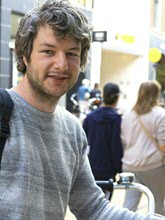
Healthy food displayed at eye height, electronic signs showing smiley faces, red carpets to ward off bikes. We are all being ‘nudged’ on a regular basis, encouraged to behave in a particular way. Koen Bandsma is researching how this works on the street. He presents a lesson in nudging through five examples.
Text: Eelco Salverda, Communication UG / photos: Merel Weijer, Communication UG
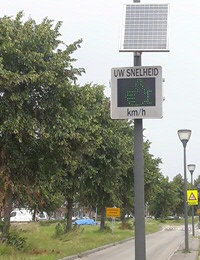
A pat on the back
How do you stop cars from driving too fast, prevent litter on the street or the chaos caused by bikes parked where they shouldn’t be? How can you make sure that people eat more healthily or get more exercise? One way is by ‘nudging’ them: pushing them towards the desired behaviour. Everyone is nudged, sometimes visibly, sometimes less so. How can you recognize a nudge? Koen Bandsma, a researcher at the UG: ‘A nudge encourages behavioural change by making use of the psychological mechanisms that underpin our behaviour, for example by making the desired behaviour more visible or more pleasant. There could be an electronic sign in a built-up area that shows a smiley face if you’re not driving too fast. This gives you immediate feedback on what you’re doing. Or ‘piano stairs’ next to an escalator. The steps are painted black and white like the keys on a piano and they play a note when you step on them. Climbing stairs, which is healthy, thus becomes more fun. Or a sign next to a provincial road that says: ‘93% of people stick to the speed limit here’. People tend to do what others do, even if they’re not always aware of it. However, nudging never involves a prohibition, or making something impossible, or guiding behaviour by using financial incentives.’
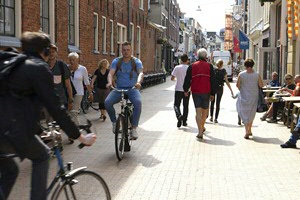
Swarming road users
Shared space, a planning concept in which as little as possible is prescribed or prohibited, is another example of nudging. There are no traffic signs or traffic lights and road users appear to swarm in and out chaotically. People have to work things out together and take responsibility. And that means watching out! What does shared space have to do with nudging? ‘A lot of behaviour is habitual,’ Bandsma explains. ‘With shared space, you break through that behaviour. You create stimuli that make it more difficult to continue with automatic behaviour. You pay more attention as a result. People often perceive shared space as less safe, but research shows that it generally leads to fewer accidents.’
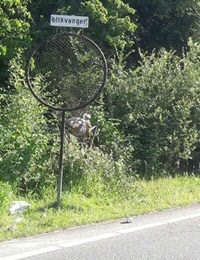
Cheap and easy
Rubbish nets, often found at the entrance to a motorway or along a cycle path to stop littering by road users, are an example of nudging before it was even heard of. The term has been used since 2008, but the principle has been around for a lot longer, says Bandsma. On the other hand, it is something that is highly relevant to the present time: ‘The government is pulling back, citizens are being given more responsibility. And it’s often relatively cheap. A red carpet, or a roll of tape to mark out a space – that’s all you need.’ Bandsma describes the rather makeshift work that nudging can resemble as ‘professional pragmatism’. ‘Measures of this kind tend not to be evaluated because nudges generally cost little and the evaluation is much more expensive. And then you’d need to start with a baseline measurement.’
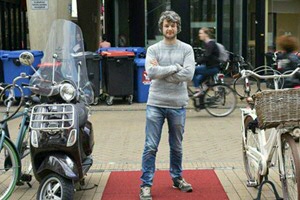
The power of the red bike mat
Because Groningen’s city centre is virtually car-free and there are so many students, you stumble – both literally and metaphorically – over the hordes of bikes that are parked or simply flung down. Recently, this prompted the suggestion that bikes should be banned altogether in some streets. Bike areas marked with tape, red carpets to stop people parking their bikes in front of shops – these are forms of nudging that help to curb the problem. ‘With a red carpet, you can clearly see the unconscious level that nudging calls on,’ explains Bandsma. ‘Red is a signal colour – it says “watch out!” Although you could quite easily put your bike there, nobody does. Something like that is cheap and it provides that little bit of space for pedestrians or emergency services in the event of an accident.’ But the problem will continue for a while yet. Car and bus traffic is increasingly discouraged in the centre of Groningen, while the number of students continues to rise. So, a ban on bikes in some streets? ‘How could you enforce that?’ asks Bandsma. ‘Also, the Groningen council is not really interested in enforcement – its policy is geared more towards education.’ And cycling is healthy after all, and doesn’t cause pollution, he adds.
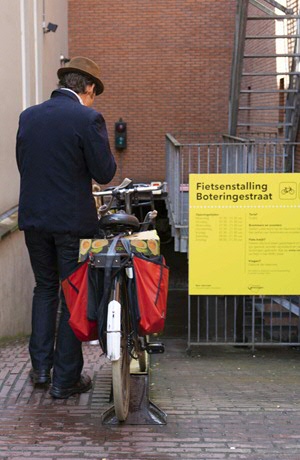
Bicycle cellars
Not all nudges are equally effective. The Frisian anthem that started playing whenever a car passed by at the right speed soon led to irritation among local residents and, Bandsma says, piano stairs were only fun for a while. So when does it work? ‘A nudge is not a panacea. You always have to combine it with other measures. The bike problem, for example, calls for a broader, integrated approach, which includes other measures such as bicycle cellars, flexible parking spots and bike stewards. In order to influence behaviour, you also need to change social norms. And if you want to change those, you need to educate people, to raise awareness. Urban planning and nudging can help a little with this.’
Isn’t it all a bit patronizing? All these prompts to influence your behaviour? ‘Using “tricks’ to guide behaviour can come across as patronizing,’ Bandsma admits. ‘It depends a bit on the nudge. I myself don’t necessarily regard a thumbs-up as patronizing. And don’t forget that it is often a result of city council policy and decisions. In a sense, this is a democratic wish. Research also shows that it’s what citizens want; they prefer it to fines or other forms of enforcement.’ So if you soon find yourself going a little out of your way to park your bike, or if you put your foot on the brake when you see an ‘angry’ smiley face, you’ll know that you’ve been nudged.
More news
-
01 December 2025
The power of movement
-
24 November 2025
RUG en Ministerie van I&W starten brede meerjarige samenwerking
